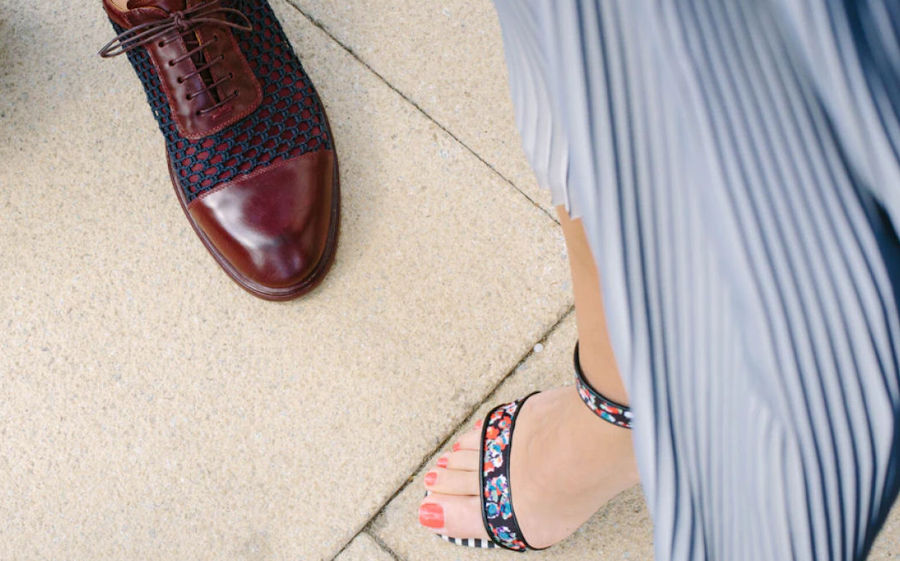
Podcast: Play in new window | Download
It has been estimated that the global footwear industry will be worth approximately $320 billion by 2023. It is an industry that continues to grow and diversify into many different sub-sectors. There are shoes that protect our feet from pain and injury and there are shoes that help us improve our performance. There are shoes that are designed to provide nothing but comfort, and there are shoes that make us look good, irrespective of comfort. Whatever your reason for owning shoes, there is a significant likelihood that you own more than one pair. Even those of us that don’t really have an interest in shoes will likely have a pair for work, a pair to wear indoors, a pair to wear on the beach and a pair to wear in the gym.
This diverse and important market sector has had a long time to get to where it is today, as there is evidence that shows that people decided that it would be a good idea to have some form of protection for their feet around 40,000 years ago.
It is probably fair to say that most shoes, irrespective of their function have the same basic characteristics but their design and the materials they are made from have changed significantly through history.
Although shoes have probably been around for about 40 millennia, it seems that the idea started to catch on probably about 10,000 years ago. The oldest pair of shoes found to date was discovered in a cave in Oregon in 1938. Resembling sandals, they were made from sagebrush bark and are about 8,000 years old. Shoes were also made from animal skins with examples of leather shoes being found in Armenia which are 3500 years old. Some shoes that have been found from this period are relatively complex in their construction too. In 1991, the remarkably preserved mummy of a man was found in the Ötztal Alps between Austria and Italy. Called Ötzi, he is the oldest naturally preserved human mummy known and he was discovered complete with the shoes that he was wearing, which were made from bearskin and deerskin and were pulled tight around his foot by a bark-string net.
Early North American natives are known to have worn similar styles of shoes to Ötzi. Generally referred to as moccasins, they were designed for comfort but were generally only worn when it was dry and cold. As they weren’t waterproof, most Native Americans walked barefoot when it was wet or if it was warm.
There is a good chance that in your shoe collection you have at least one pair which are brought out of the closet when it’s time to head to the beach, but the precursor to the flip-flop was in use in Egypt at least 4,000 years ago. We know this because we can see them depicted in ancient Egyptian murals. They could be made from many different materials. For example, the Egyptians favoured thong-sandals made from papyrus or palm leaves, whereas in India they made them from wood.
Many saw the use of shoes as an indulgence though, preferring to go barefoot. Competitors at the Ancient Olympics competed barefoot and Alexander the Great’s warriors conquered territory after territory wearing nothing on their feet. Even the gods of ancient Greece were depicted barefoot.
The Romans thought differently though, and although they adopted many Greek fashions and other parts of their culture, the Romans thought that footwear gave them status and shoes were a necessity for a civilised culture, so it probably goes without saying that slaves and paupers still went barefoot.
Shoes started to indicate other things as well. For example, you could tell the rank of a Roman soldier from his footwear. The higher it went up his leg, the greater his rank. From around 4 BC, colour started to have significance too. As it was expensive to lighten leather, a paler coloured shoe demonstrated wealth. At the same time an industry in shoemaking began to take hold as the skills of the cobbler started to be in ever greater demand, with shoes being required for different occasions and used for different purposes.
As time marched on and we entered the middle ages shoes started to develop even more different characteristics and styles. For example, chopines were created in 15th century Turkey, which resemble modern-day platform shoes. They could be up to 7 or 8 inches high and denoted status and wealth.
During the 16th century, high-heeled shoes started to be used as a way of making a person look taller, especially those people in positions of authority, including royals such as Catherine de Medici and Queen Mary I of England. They were initially used by women, but by the late 1500s, men also had started to wear them and the term ‘well-heeled’ indicated a person’s status by the heel on their shoes. Not everyone was free to indulge in the heel of their choice though. In 17th century France it was illegal to wear red high-heeled shoes unless you were King Louis XIV himself or a member of his royal court.
It is during the 17th century that we see the introduction of shoes that have a separate sewn-on sole and there was also a gradual move towards shoes that were specifically made for the left and right foot and these are the forerunners to today’s modern shoes.
Shoemaking became more of a commercial endeavour from the middle of the 18th century with warehouses stocking all sorts of different types of shoes made by hand as part of local cottage industries. However, by the end of the 19th century, everything had been completely mechanised, allowing for large scale production in huge factories helped along the way by innovations such as riveting machines as patented by Thomas Crick in Leicester in 1853 and the introduction of the sewing machine in 1846.
Other advances were introduced later in the century including the use of rubber heels for boots and shoes using a patent that was awarded to Humphrey O’Sullivan of Massachusetts, USA in January 1899. And by 1910 we also saw the introduction of a process to glue soles to shoes instead of sewing them on.
As the 20th century progressed, new materials and processes continued to be introduced although not all of this progress may be seen as positive. For example, due to the use of modern plastics and other similar, non-biodegradable material it has been estimated that most modern shoes would take around 1000 years to decompose, although some manufacturers have picked up on this fact and have started making shoes from completely biodegradable materials. In 2007 the global shoe industry was worth over $107 billion and is expected to triple by 2023. China is the largest producer of shoes with 63% of the world’s production, but if you want high end, higher-priced shoes, then you need to head to Europe. But no matter where you buy your next pair of shoes, one thing is for certain, the days of spending the day barefoot are long gone and won’t be coming back any time soon.
Podcast: Play in new window | Download





